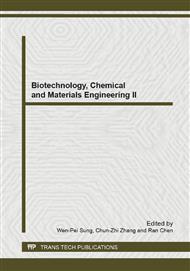p.206
p.211
p.215
p.219
p.223
p.229
p.233
p.238
p.242
A Study on the Photocatalytic Degradation of Organophosphorous Pesticide Wastewater by the New Photocatalyst AgBr/TiO2
Abstract:
In the experiment a new photocatalyst AgBr/TiO2 was prepared by modifying TiO2 and was applied to degrade the organophosphorous pesticide wastewater . Some factors influencing the degradation were discussed. The results showed that the AgBr/TiO2 had higher photocatalytic activity; when the quality of photocatalyst was 1.2g, the initial concentration of the organophosphorous pesticide wastewater was 100mg/L, the PH was 11 and the degradation time was 100 minutes,the treatment effect of photocatalytic degradating organophosphorous pesticide wastewater was the best.
Info:
Periodical:
Pages:
223-228
Citation:
Online since:
January 2013
Keywords:
Price:
Сopyright:
© 2013 Trans Tech Publications Ltd. All Rights Reserved
Share:
Citation:


